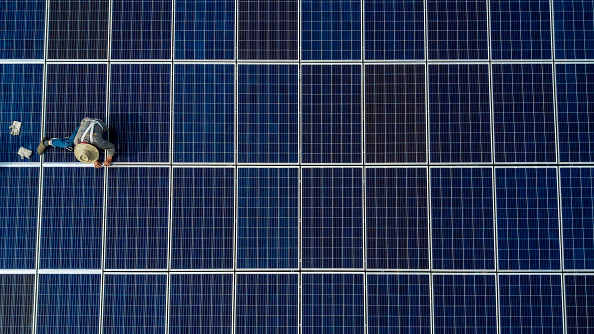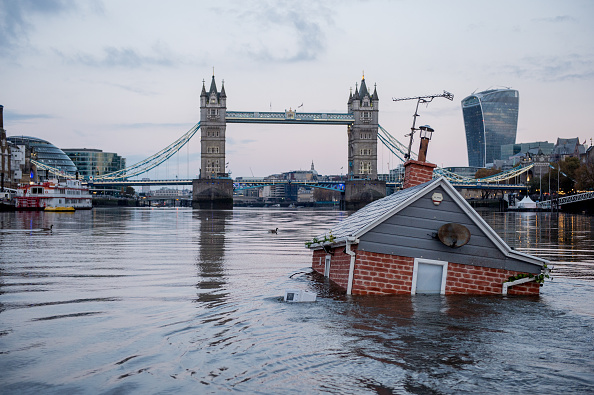
A Chinese worker from Wuhan Guangsheng Photovoltaic Company works on a solar panel project on the roof of a 47-story building in Wuhan, China, May 15, 2017. /Getty
A Chinese worker from Wuhan Guangsheng Photovoltaic Company works on a solar panel project on the roof of a 47-story building in Wuhan, China, May 15, 2017. /Getty
Editor's note: Alexander Ayertey Odonkor is an economic consultant, chartered financial analyst and chartered economist with an in-depth understanding of the economic landscape of countries in Asia and Africa. The article reflects the author's opinions and not necessarily the views of CGTN.
In the last few weeks, several regions of the world have experienced extreme climate events, which range from floods in China, Europe and India to drought and high temperatures in Serbia, which led to wildfires, even reaching the North Pole for the first time in history. Similarly, in Greece and Turkey, the impact of wildfire has been so devastating that the forest cover was lost and many people were forced to leave their home. In North America, the situation is quite the same, as the heavy haze from raging fires has drifted across the U.S. and Canada, exacerbating air pollution.
For many decades, the world has been experiencing the never-ending ruinous impact of extreme weathers, which are mainly attributed to climate change. The recurrent heatwaves and floods, as well as rising sea levels and water scarcity has paint a vivid picture of a looming crisis for the world.
According to a report published on August 2021 from the Intergovernmental Panel on Climate Change (IPCC), each of the last four decades has been progressively warmer than the preceding decade since 1850, which confirms the impending cataclysmic impact of climate change.
IPCC says that the average global surface temperature in the first two decades of the 21st century was 0.99 degrees Celsius higher than the 1850-1900 level, and more recently, from 2011 to 2020, it was 1.09 degrees Celsius warmer than the historic base period.
The rising temperature has been accompanied with unprecedented changes. For example, between 2011 and 2020, the annual average Arctic sea ice area reached its lowest level since 1850.
Researchers have identified human-induced climate change as the main driver of climate change. The increasing contribution of human activities to greenhouse gas concentrations stimulates climate forcing, a change in the Earth's energy balance that leads to warming or cooling effects over time.

Environmental protest group Extinction Rebellion floats a replica of a British house in front of Tower Bridge on the river Thames in an action entitled 'Our House Is Flooding,' November 10, 2019. /Getty
Environmental protest group Extinction Rebellion floats a replica of a British house in front of Tower Bridge on the river Thames in an action entitled 'Our House Is Flooding,' November 10, 2019. /Getty
To avert the climate crisis, it is essential to mitigate all human activities that foster this change. Practically, this daunting task cannot be achieved without a transition of the world's energy sector from utilizing fossil fuel to clean energy resources.
According to the International Energy Agency, the energy sector accounts for about three-quarters of the world's entire greenhouse gas emissions, which positions this industry as the focal point in the fight against climate change. Transforming the way energy is produced, transported and consumed is critical in reaching net-zero carbon emissions by 2050 and limiting global warming to 1.5 degrees Celsius.
Furthermore, this gargantuan transformation cannot be achieved without the support of the global financial system, which is expected to provide adequate investment in clean energy infrastructure and related research that can accelerate the invention of clean energy technologies and meet the world's growing energy demand.
Although green banking is instrumental in developing clean energy, this financial resource has its downsides. With a large proportion of bank deposits categorized as short- and medium-term transactions, banks are usually reluctant to lend to clean energy projects, particularly those requiring long-term financing. In most cases, banks prefer lending to less risky programs, which is a major setback limiting access to green finance in many developing countries.
This finance gap for clean energy infrastructure development could be addressed by involving non-bank financial institutions, such as insurance firms and pension funds, which have the capacity to provide long-term funding.
While the integration of the services of these financial institutions to improve green finance has been anything but easy for many countries, China has been making remarkable progress in this field.
In my previous article, I discussed the impressive progress China is making in developing clean energy infrastructure in an effort to achieve carbon neutrality. For example in 2020, China installed the world's largest capacity of renewable energy, which amounted to 895 gigawatts. In the same year, the combined renewable energy capacity of Canada, Germany, France, United States, Japan and Italy was even less than China's total renewable energy output.
How did China become the largest producer of renewable energy? Well, this is partly because China has the highest number of patents in renewable energy technologies and provides adequate investment via green finance.
By the end of 2020, China's green loans amounted to $1.8 trillion, the largest in the world. In the same year, the country's total green bonds reached $125 billion, representing the world's second-largest. By strengthening green finance via fintech for the development of clean energy infrastructure, China is making significant progress towards achieving carbon neutrality by 2060.
Even though there is still room for improvement, China's commitment to developing green finance and supporting the transition from fossil fuel to clean energy is worthy of emulation. Countries could support international green projects, such as the Belt and Road Initiative, to demonstrate their cooperation and dedication to achieving carbon neutrality and save the world from climate change. .
(If you want to contribute and have specific expertise, please contact us at opinions@cgtn.com.)

